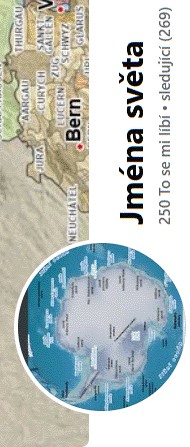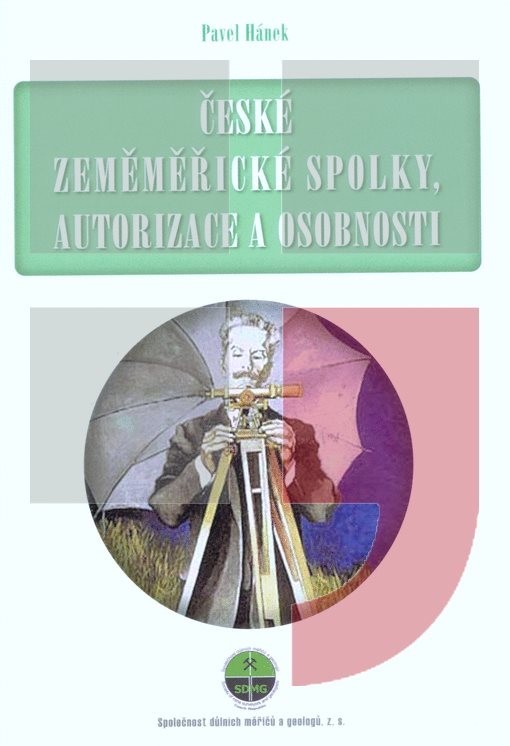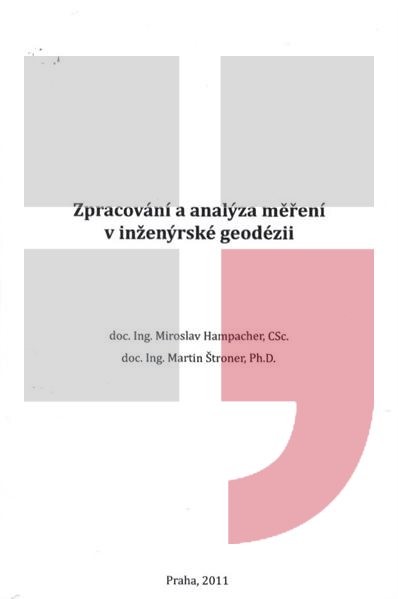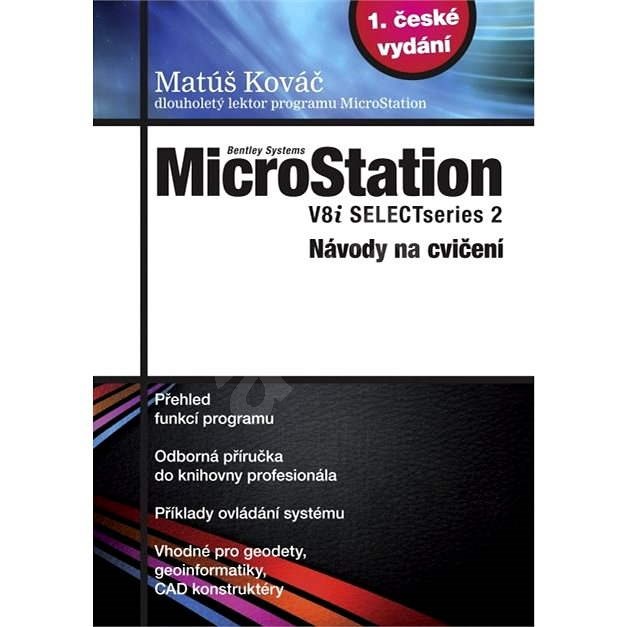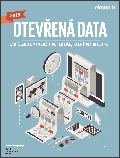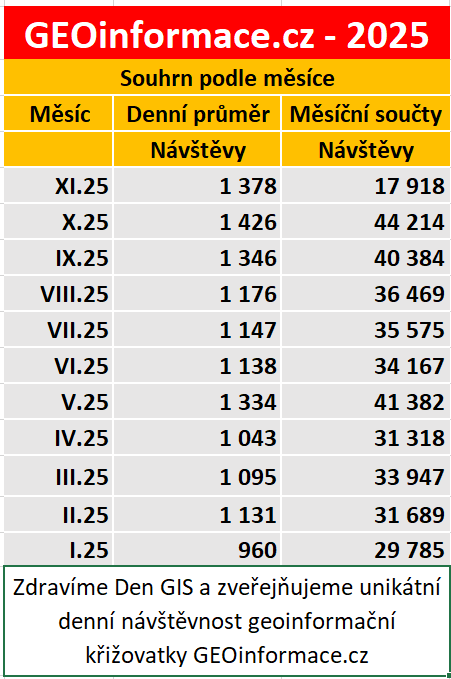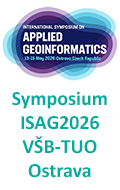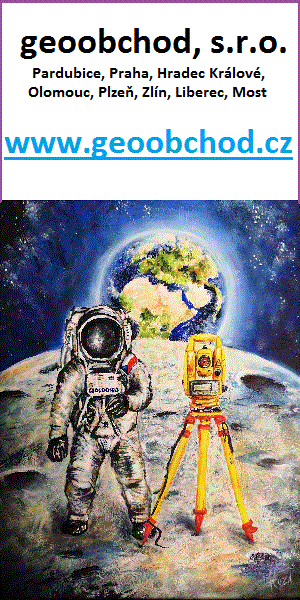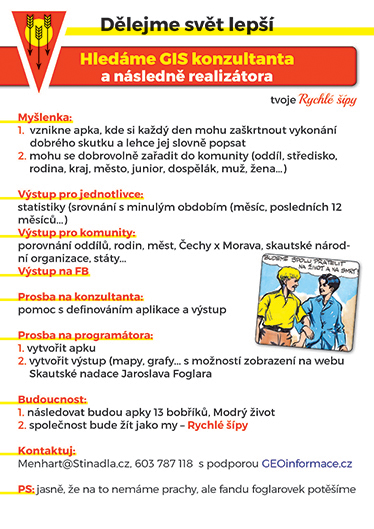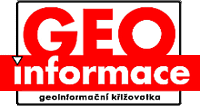zprávy
zdroje zpráv:Rozhovor s Ing. Janem Bukovským, Ph.D. o využití tabletů ZEBRA na plavidlech pro údržbu vodních cest i hlídkových člunů Státní plavební správy a Policie ČR
20.4.2021 2:00 VARS.cz
Rozhovor s Ing. Janem Bukovským, Ph.D. o využití tabletů ZEBRA na plavidlech pro údržbu vodních cest i hlídkových člunů Státní plavební správy a Policie ČR.
20.4.2021 2:00 VARS.cz
Winners presented with ESA-EGU Excellence award
19.4.2021 19:00 ESA Observing the Earth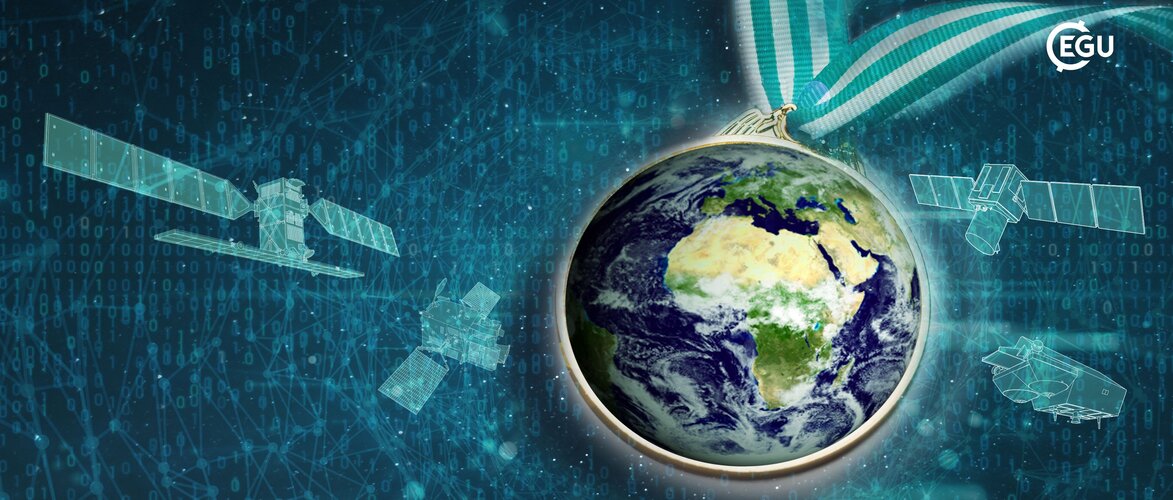
The winners of the first ESA-EGU Excellence Award were awarded their prizes earlier today at the virtual EGU General Assembly ceremony, attended by ESA’s Director General, Josef Aschbacher and ESA’s Acting Director of Earth Observation Programmes, Toni Tolker-Nielsen.
Hydro Solutions Consulting, LLC Joins Dewberry
19.4.2021 17:26 GISCafe.com Webcasts-Webinars Florida-based water firm now backed by more capacity; forming Dewberry | HydroFAIRFAX, Va., April 19, 2021 — (PRNewswire) — …
Draganfly Announces Record Revenue in Fourth Quarter and Fiscal 2020 Financial Results
19.4.2021 17:26 GISCafe.com Webcasts-Webinars Vancouver, BC., April 19, 2021 (GLOBE NEWSWIRE) -- Draganfly Inc. (OTCQB: DFLYF) (CSE: DFLY) (FSE: 3U8) (“Draganfly” or the “Company”), an …BlackSky Increases Capacity as Latest Satellite Enters Commercial Operations
19.4.2021 16:39 GISCafe.com Webcasts-Webinars Company Ships Two Additional Satellites to Launch Facility, Reinforcing its Speed to Space and Rapid Delivery of First-to-Know InsightsHERNDON, Va. …
Altavation Provides On-Demand Nationwide Drone Imaging for Real Estate
19.4.2021 16:39 GISCafe.com Webcasts-Webinars SYRACUSE, N.Y., April 19, 2021 — (PRNewswire) — Altavation is now available nationwide – accessible and affordable on-demand …Hexagon US Federal selected by General Atomics Aeronautical for ISR Projects
19.4.2021 16:39 GISCafe.com Webcasts-Webinars Hexagon's Luciad Portfolio provides the geospatial foundation for advanced visualization and analysisCHANTILLY, Va., April 19, 2021 — …
Skydweller Aero Inc. Validates Initial Flight Hardware and Autopilot Software
19.4.2021 16:39 GISCafe.com Webcasts-Webinars Flight Test Enables Critical Data Collection for Broadened Autonomous Software DevelopmentOKLAHOMA CITY, April 19, 2021 — (PRNewswire) — …
Nové číslo GaKO
19.4.2021 16:00
ÚGKK SR
Nové číslo časopisu Geodetického a Kartografického Obzoru 04/2021
rada/odborný rada - vedoucí oddělení dokumentace KN Katastrálního pracoviště Jindřichův Hradec (ID S
19.4.2021 15:12 ČÚZK - volná místa Katastrální úřad pro Jihočeský kraj Katastrální pracoviště Jindřichův Hradec vypisuje výběrové řízení na místo rada/odborný rada - vedoucí oddělení dokumentace KN Katastrálního pracoviště Jindřichův Hradec (ID Srada/odborný rada - vedoucí oddělení dokumentace KN Katastrálního pracoviště Jindřichův Hradec (ID S
19.4.2021 15:12 ČÚZK - předpisy a opatření Katastrální úřad pro Jihočeský kraj Katastrální pracoviště Jindřichův Hradecvypisuje výběrové řízení na místo
rada/odborný rada - vedoucí oddělení dokumentace KN Katastrálního pracoviště Jindřichův Hradec (ID SM 30000211/30003835)
rada/odborný rada - vedoucí oddělení dokumentace KN Katastrálního pracoviště Jindřichův Hradec (ID S
19.4.2021 15:12 ČÚZK /Urady/Katastralni-urady/Katastralni-urady/Katastralni-urad-pro-Jihocesky-kraj/Uredni-deska/Oznameni-a-jina-uredni-sdeleni/Volna-mista/DMS/rada-odborny-rada-vedouci-oddeleni-dokumentace-Kodborný referent – obnova katastrálního operátu v oddělení obnovy katastrálního operátu (3030) Katas
19.4.2021 14:52 ČÚZK /Urady/Katastralni-urady/Katastralni-urady/Katastralni-urad-pro-Jihocesky-kraj/Uredni-deska/Oznameni-a-jina-uredni-sdeleni/Volna-mista/DMS/odborny-referent-–-obnova-katastralniho-operatu-vodborný referent – obnova katastrálního operátu v oddělení obnovy katastrálního operátu (3030) Katas
19.4.2021 14:52 ČÚZK - předpisy a opatření Katastrální úřad pro Jihočeský kraj odbor obnovy katastrálního operátuvypisuje výběrové řízení na místo
odborný referent – obnova katastrálního operátu v oddělení obnovy katastrálního operátu (3030) Katastrálního úřadu pro Jihočeský kraj (ID SM 30000055/30003679)
odborný referent – obnova katastrálního operátu v oddělení obnovy katastrálního operátu (3030) Katas
19.4.2021 14:52 ČÚZK - volná místa Katastrální úřad pro Jihočeský kraj odbor obnovy katastrálního operátu vypisuje výběrové řízení na místo odborný referent – obnova katastrálního operátu v oddělení obnovy katastrálního operátu (3030) KatasTime to roll up your sleeves: Galileo Masters 2021 now open!
19.4.2021 13:11 European GNSS Agency
The 2021 edition of the Galileo Masters opens for submissions on April 19. As in previous years, the 2021 competition is looking for services, applications and business cases that use EGNSS (Galileo and EGNOS), either alone or in synergy with other space components, to tackle important challenges faced by business and society. Want to take your EGNSS-based innovative idea from the drawing board to the market? Click here for more information.
The prize pool in this year’s Galileo Masters is EUR 785,000, which will be spread across seven key challenges, three of which are supported by the European GNSS Agency (GSA). The topics of the three GSA challenges build on last year themes, so if you had an idea for last year’s competition that you didn’t manage to bring to fruition, now is the time to dust it off and get it ready for this year!
3 GSA challenges
The EU Space Programme offers free and open data and services that can help monitor and potentially mitigate the impact of the coronavirus outbreak. This is the focus of the first challenge from the GSA - Space for Being Safe and Healthy. Under this challenge, we are looking for solutions that use downstream space data provided by Galileo, EGNOS and/or Copernicus to help stem the spread of COVID-19 or to mitigate its impact in the short and long term.
Read this: MyGalileoSolution & MyGalileoDrone: A word from the winners
In our Space for Fun challenge, we are looking for solutions that use Galileo and EGNOS data in the gaming, sports and leisure, and tourism markets. This challenge covers a number of market segments and so there is a wide scope for innovative ideas requiring accurate and authenticated positioning. Finally, we are looking for new applications to address other ongoing challenges, including climate change and environmental degradation, which require urgent attention and innovative solutions. These are the focus of the third GSA challenge - Space for our Planet.
“The COVID pandemic is still with us and, while there were some excellent ideas in last year’s competition for solutions to help society mitigate and adapt to the effects of the pandemic, there is still a lot of scope to leverage Galileo and EGNOS, either alone or in synergy with Earth observation data from Copernicus, to help us in facing this challenge,” said Rodrigo da Costa, Executive Director at the GSA. “This is why we have decided to give innovators another opportunity to put forward their ideas this year,” he said.
Watch this: Celebrating 2 billion Galileo enabled smartphones
Through the Galileo Masters, the GSA supports entrepreneurs and start-ups in making their ideas a reality, producing services and applications that respond to societal needs and that address some of the most pressing challenges that we currently face. Another initiative that supports start-ups, and one that might be potentially very useful for Galileo Masters applicants, helping them to get inspiration and to flesh out their ideas, is the new Space Crossroads – a series of online broadcasts where industry leaders, experts, investors and big players share their space experience.
Inspiration from past ideas
If an idea for an application has not yet crystallised in your mind, perhaps you can take some inspiration from past winners of the Galileo Masters prize. The overall prize in the Galileo Masters 2020 went to Angsa Robotics for “Clive,” Germany’s first autonomous trash collection robot, which collects small pieces of rubbish left on grass or gravel that would otherwise cause ecological and economic problems. Thanks to its unique artificial neural network architecture, “Clive” can move independently while detecting and localising individual objects, which enables it to clean grass and gravel areas.
The overall winner of the 2019 Galileo Masters was Performance Cockpit, a business intelligence system that aims to lessen the environmental footprint of the aviation sector by increasing operational efficiency and considerably reducing fuel consumption. The Aeroficial Intelligence system leverages Galileo positioning and EGNOS augmentation in data-driven solutions that increase operational efficiency and considerably reduce fuel consumption in the aviation industry.
Inspired? Sign up now and take your idea to the next level in the Galileo Masters 2021!
Media note: This feature can be republished without charge provided the European GNSS Agency (GSA) is acknowledged as the source at the top or the bottom of the story. You must request permission before you use any of the photographs on the site. If you republish, we would be grateful if you could link back to the GSA website (http://www.gsa.europa.eu).
Time to roll up your sleeves: Galileo Masters 2021 now open!
19.4.2021 13:11 European GNSS Agency
The 2021 edition of the Galileo Masters opens for submissions on April 19. As in previous years, the 2021 competition is looking for services, applications and business cases that use EGNSS (Galileo and EGNOS), either alone or in synergy with other space components, to tackle important challenges faced by business and society. Want to take your EGNSS-based innovative idea from the drawing board to the market? Click here for more information.
The prize pool in this year’s Galileo Masters is EUR 785,000, which will be spread across seven key challenges, three of which are supported by the European GNSS Agency (GSA). The topics of the three GSA challenges build on last year themes, so if you had an idea for last year’s competition that you didn’t manage to bring to fruition, now is the time to dust it off and get it ready for this year!
3 GSA challenges
The EU Space Programme offers free and open data and services that can help monitor and potentially mitigate the impact of the coronavirus outbreak. This is the focus of the first challenge from the GSA - Space for Being Safe and Healthy. Under this challenge, we are looking for solutions that use downstream space data provided by Galileo, EGNOS and/or Copernicus to help stem the spread of COVID-19 or to mitigate its impact in the short and long term.
Read this: MyGalileoSolution & MyGalileoDrone: A word from the winners
In our Space for Fun challenge, we are looking for solutions that use Galileo and EGNOS data in the gaming, sports and leisure, and tourism markets. This challenge covers a number of market segments and so there is a wide scope for innovative ideas requiring accurate and authenticated positioning. Finally, we are looking for new applications to address other ongoing challenges, including climate change and environmental degradation, which require urgent attention and innovative solutions. These are the focus of the third GSA challenge - Space for our Planet.
“The COVID pandemic is still with us and, while there were some excellent ideas in last year’s competition for solutions to help society mitigate and adapt to the effects of the pandemic, there is still a lot of scope to leverage Galileo and EGNOS, either alone or in synergy with Earth observation data from Copernicus, to help us in facing this challenge,” said Rodrigo da Costa, Executive Director at the GSA. “This is why we have decided to give innovators another opportunity to put forward their ideas this year,” he said.
Watch this: Celebrating 2 billion Galileo enabled smartphones
Through the Galileo Masters, the GSA supports entrepreneurs and start-ups in making their ideas a reality, producing services and applications that respond to societal needs and that address some of the most pressing challenges that we currently face. Another initiative that supports start-ups, and one that might be potentially very useful for Galileo Masters applicants, helping them to get inspiration and to flesh out their ideas, is the new Space Crossroads – a series of online broadcasts where industry leaders, experts, investors and big players share their space experience.
Inspiration from past ideas
If an idea for an application has not yet crystallised in your mind, perhaps you can take some inspiration from past winners of the Galileo Masters prize. The overall prize in the Galileo Masters 2020 went to Angsa Robotics for “Clive,” Germany’s first autonomous trash collection robot, which collects small pieces of rubbish left on grass or gravel that would otherwise cause ecological and economic problems. Thanks to its unique artificial neural network architecture, “Clive” can move independently while detecting and localising individual objects, which enables it to clean grass and gravel areas.
The overall winner of the 2019 Galileo Masters was Performance Cockpit, a business intelligence system that aims to lessen the environmental footprint of the aviation sector by increasing operational efficiency and considerably reducing fuel consumption. The Aeroficial Intelligence system leverages Galileo positioning and EGNOS augmentation in data-driven solutions that increase operational efficiency and considerably reduce fuel consumption in the aviation industry.
Inspired? Sign up now and take your idea to the next level in the Galileo Masters 2021!
Media note: This feature can be republished without charge provided the European GNSS Agency (GSA) is acknowledged as the source at the top or the bottom of the story. You must request permission before you use any of the photographs on the site. If you republish, we would be grateful if you could link back to the GSA website (http://www.gsa.europa.eu).
Time to roll up your sleeves: Galileo Masters 2021 now open!
19.4.2021 13:11 European GNSS Agency
The 2021 edition of the Galileo Masters opens for submissions on April 19. As in previous years, the 2021 competition is looking for services, applications and business cases that use EGNSS (Galileo and EGNOS), either alone or in synergy with other space components, to tackle important challenges faced by business and society. Want to take your EGNSS-based innovative idea from the drawing board to the market? Click here for more information.
The prize pool in this year’s Galileo Masters is EUR 785,000, which will be spread across seven key challenges, three of which are supported by the European GNSS Agency (GSA). The topics of the three GSA challenges build on last year themes, so if you had an idea for last year’s competition that you didn’t manage to bring to fruition, now is the time to dust it off and get it ready for this year!
3 GSA challenges
The EU Space Programme offers free and open data and services that can help monitor and potentially mitigate the impact of the coronavirus outbreak. This is the focus of the first challenge from the GSA - Space for Being Safe and Healthy. Under this challenge, we are looking for solutions that use downstream space data provided by Galileo, EGNOS and/or Copernicus to help stem the spread of COVID-19 or to mitigate its impact in the short and long term.
Read this: MyGalileoSolution & MyGalileoDrone: A word from the winners
In our Space for Fun challenge, we are looking for solutions that use Galileo and EGNOS data in the gaming, sports and leisure, and tourism markets. This challenge covers a number of market segments and so there is a wide scope for innovative ideas requiring accurate and authenticated positioning. Finally, we are looking for new applications to address other ongoing challenges, including climate change and environmental degradation, which require urgent attention and innovative solutions. These are the focus of the third GSA challenge - Space for our Planet.
“The COVID pandemic is still with us and, while there were some excellent ideas in last year’s competition for solutions to help society mitigate and adapt to the effects of the pandemic, there is still a lot of scope to leverage Galileo and EGNOS, either alone or in synergy with Earth observation data from Copernicus, to help us in facing this challenge,” said Rodrigo da Costa, Executive Director at the GSA. “This is why we have decided to give innovators another opportunity to put forward their ideas this year,” he said.
Watch this: Celebrating 2 billion Galileo enabled smartphones
Through the Galileo Masters, the GSA supports entrepreneurs and start-ups in making their ideas a reality, producing services and applications that respond to societal needs and that address some of the most pressing challenges that we currently face. Another initiative that supports start-ups, and one that might be potentially very useful for Galileo Masters applicants, helping them to get inspiration and to flesh out their ideas, is the new Space Crossroads – a series of online broadcasts where industry leaders, experts, investors and big players share their space experience.
Inspiration from past ideas
If an idea for an application has not yet crystallised in your mind, perhaps you can take some inspiration from past winners of the Galileo Masters prize. The overall prize in the Galileo Masters 2020 went to Angsa Robotics for “Clive,” Germany’s first autonomous trash collection robot, which collects small pieces of rubbish left on grass or gravel that would otherwise cause ecological and economic problems. Thanks to its unique artificial neural network architecture, “Clive” can move independently while detecting and localising individual objects, which enables it to clean grass and gravel areas.
The overall winner of the 2019 Galileo Masters was Performance Cockpit, a business intelligence system that aims to lessen the environmental footprint of the aviation sector by increasing operational efficiency and considerably reducing fuel consumption. The Aeroficial Intelligence system leverages Galileo positioning and EGNOS augmentation in data-driven solutions that increase operational efficiency and considerably reduce fuel consumption in the aviation industry.
Inspired? Sign up now and take your idea to the next level in the Galileo Masters 2021!
Media note: This feature can be republished without charge provided the European GNSS Agency (GSA) is acknowledged as the source at the top or the bottom of the story. You must request permission before you use any of the photographs on the site. If you republish, we would be grateful if you could link back to the GSA website (http://www.gsa.europa.eu).
Time to roll up your sleeves: Galileo Masters 2021 now open!
19.4.2021 13:11 European GNSS Agency
The 2021 edition of the Galileo Masters opens for submissions on April 19. As in previous years, the 2021 competition is looking for services, applications and business cases that use EGNSS (Galileo and EGNOS), either alone or in synergy with other space components, to tackle important challenges faced by business and society. Want to take your EGNSS-based innovative idea from the drawing board to the market? Click here for more information.
The prize pool in this year’s Galileo Masters is EUR 785,000, which will be spread across seven key challenges, three of which are supported by the European GNSS Agency (GSA). The topics of the three GSA challenges build on last year themes, so if you had an idea for last year’s competition that you didn’t manage to bring to fruition, now is the time to dust it off and get it ready for this year!
3 GSA challenges
The EU Space Programme offers free and open data and services that can help monitor and potentially mitigate the impact of the coronavirus outbreak. This is the focus of the first challenge from the GSA - Space for Being Safe and Healthy. Under this challenge, we are looking for solutions that use downstream space data provided by Galileo, EGNOS and/or Copernicus to help stem the spread of COVID-19 or to mitigate its impact in the short and long term.
Read this: MyGalileoSolution & MyGalileoDrone: A word from the winners
In our Space for Fun challenge, we are looking for solutions that use Galileo and EGNOS data in the gaming, sports and leisure, and tourism markets. This challenge covers a number of market segments and so there is a wide scope for innovative ideas requiring accurate and authenticated positioning. Finally, we are looking for new applications to address other ongoing challenges, including climate change and environmental degradation, which require urgent attention and innovative solutions. These are the focus of the third GSA challenge - Space for our Planet.
“The COVID pandemic is still with us and, while there were some excellent ideas in last year’s competition for solutions to help society mitigate and adapt to the effects of the pandemic, there is still a lot of scope to leverage Galileo and EGNOS, either alone or in synergy with Earth observation data from Copernicus, to help us in facing this challenge,” said Rodrigo da Costa, Executive Director at the GSA. “This is why we have decided to give innovators another opportunity to put forward their ideas this year,” he said.
Watch this: Celebrating 2 billion Galileo enabled smartphones
Through the Galileo Masters, the GSA supports entrepreneurs and start-ups in making their ideas a reality, producing services and applications that respond to societal needs and that address some of the most pressing challenges that we currently face. Another initiative that supports start-ups, and one that might be potentially very useful for Galileo Masters applicants, helping them to get inspiration and to flesh out their ideas, is the new Space Crossroads – a series of online broadcasts where industry leaders, experts, investors and big players share their space experience.
Inspiration from past ideas
If an idea for an application has not yet crystallised in your mind, perhaps you can take some inspiration from past winners of the Galileo Masters prize. The overall prize in the Galileo Masters 2020 went to Angsa Robotics for “Clive,” Germany’s first autonomous trash collection robot, which collects small pieces of rubbish left on grass or gravel that would otherwise cause ecological and economic problems. Thanks to its unique artificial neural network architecture, “Clive” can move independently while detecting and localising individual objects, which enables it to clean grass and gravel areas.
The overall winner of the 2019 Galileo Masters was Performance Cockpit, a business intelligence system that aims to lessen the environmental footprint of the aviation sector by increasing operational efficiency and considerably reducing fuel consumption. The Aeroficial Intelligence system leverages Galileo positioning and EGNOS augmentation in data-driven solutions that increase operational efficiency and considerably reduce fuel consumption in the aviation industry.
Inspired? Sign up now and take your idea to the next level in the Galileo Masters 2021!
Media note: This feature can be republished without charge provided the European GNSS Agency (GSA) is acknowledged as the source at the top or the bottom of the story. You must request permission before you use any of the photographs on the site. If you republish, we would be grateful if you could link back to the GSA website (http://www.gsa.europa.eu).
Celebrate Earth Day with ESA
19.4.2021 13:05 ESA Observing the Earth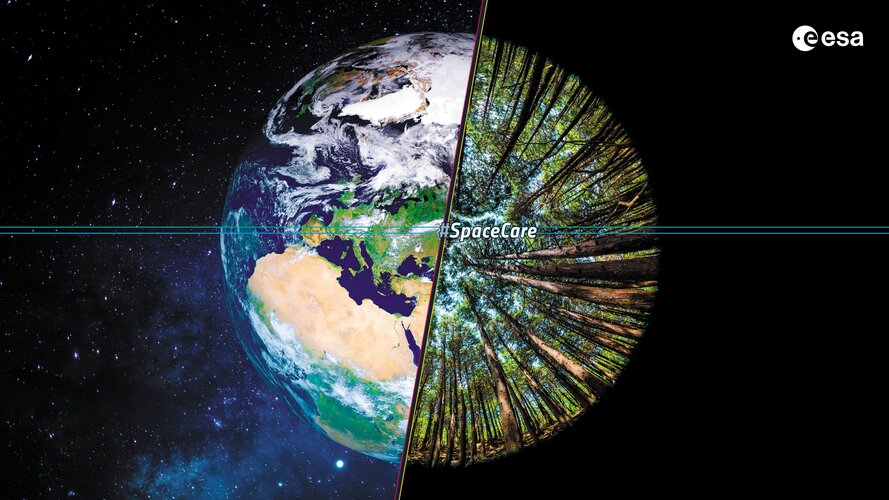
At ESA, every day is Earth Day. As we humans continue to subject our home planet to increasing pressures, we are better placed than ever to understand and monitor the consequences of what we inflict. Astronauts onboard the International Space Station give us the human perspective of how beautiful Earth is, while satellites orbiting above return systematic measures to take the pulse of our planet 24 hours a day.
These measurements allow us to understand how Earth works as a system and how human activity is changing natural processes, leading to climate change. This information is fundamental to global climate policy-making through international bodies such as the Intergovernmental Panel on Climate Change and UN Climate Change Conferences, the next being COP26 later this year.
Celebrate Earth Day with ESA with this compilation of content and activities now available.
Odborný referent – poskytování informací KN, poskytování podkladů, nahlížení do KN, poskytování info
19.4.2021 10:14 ČÚZK - volná místa Katastrální úřad pro Zlínský kraj Katastrální pracoviště Vsetín vypisuje výběrové řízení na místo Odborný referent – poskytování informací KN, poskytování podkladů, nahlížení do KN, poskytování infoOdborný referent – poskytování informací KN, poskytování podkladů, nahlížení do KN, poskytování info
19.4.2021 10:14 ČÚZK - předpisy a opatření Katastrální úřad pro Zlínský kraj Katastrální pracoviště Vsetínvypisuje výběrové řízení na místo
Odborný referent – poskytování informací KN, poskytování podkladů, nahlížení do KN, poskytování informací PK v oddělení dokumentace KN Katastrálního pracoviště Vsetín
Dubnový Missing Maps Mapathon (pozvánka)
19.4.2021 8:10 GISportal.cz
Další mapathon, během kterého můžete podpořit činnost Lékařů bez hranic, bude poslední úterý v měsíci. Rádi vás tam uvidíme. Zaregistrujte se na třetí letošní mapathon s Missing Maps Česko 27. dubna 2021 od 18:00 hodin. Zaregistrujte se brzy, protože je omezený počet míst, a ať můžeme v rámci core týmu domluvit zavčas školitele. Doufáme, že […]
The post Dubnový Missing Maps Mapathon (pozvánka) appeared first on GISportal.cz.
Úřední hodiny
19.4.2021 7:27 ČÚZK - předpisy a opatření Katastrální úřad pro Ústecký kraj - Katastrální pracoviště Děčín zveřejnil novou aktualitu: S účinností od 19.4.2021 je provedena změna Úředních hodin na Katastrálním pracovišti Děčín Katastrálního úřadu pro Ústecký kraj.Úřední hodiny jsou nově pro všechny agendy:
Pondělí, Středa : 8:00 - 17:00
Úterý, Čtvrtek : 8:00 - 14:00
Pátek : 8:00 - 12:00
Úřední hodiny od 19.4. 2021
19.4.2021 7:05 ČÚZK /Urady/Katastralni-urady/Katastralni-urady/Katastralni-urad-pro-Liberecky-kraj/Katastralni-pracoviste/KP-Semily/O-uradu/Aktuality/Uredni-hodiny-od-19-4-2021Úřední hodiny od 19.4. 2021
19.4.2021 7:05 ČÚZK - předpisy a opatření Katastrální úřad pro Liberecký kraj - Katastrální pracoviště Semily zveřejnil novou aktualitu:Katastrální úřad pro Liberecký kraj, Katastrální pracoviště Semily oznamuje, že od pondělí 19. 4. 2021 se obnovují úřední hodiny platné před vyhlášením nouzového stavu, tedy:
pondělí a středa 8:00 - 17:00,
úterý a čtvrtek 8:00 - 14:00,
pátek 8:00 - 12:00.
Podání již není možné doručit vhozením do sběrného boxu (schránky umístěné vlevo od vchodových dveří pracoviště).
Úřední hodiny od 19.4. 2021
19.4.2021 7:05 ČÚZK - předpisy a opatření Katastrální úřad pro Liberecký kraj - Katastrální pracoviště Semily zveřejnil novou aktualitu:Katastrální úřad pro Liberecký kraj, Katastrální pracoviště Semily oznamuje, že od pondělí 19. 4. 2021 se obnovují úřední hodiny platné před vyhlášením nouzového stavu, tedy:
pondělí a středa 8:00 - 17:00,
úterý a čtvrtek 8:00 - 14:00,
pátek 8:00 - 12:00.
Podání již není možné doručit vhozením do sběrného boxu (schránky umístěné vlevo od vchodových dveří pracoviště).
Otevřená inovační platforma ESA
18.4.2021 20:26 Česká kosmická kancelářK České kosmické kanceláři se občas obracejí zájemci o zapojení do kosmických program se žádostí o radu, jaké jsou možnosti a jaký postupem by toho mohli dosáhnout. Konkrétní odpověď vždy záleží na konkrétní představě každého zájemce.
Report: St. Mary’s County Maryland Can Meet Renewable Solar Energy Goals with Smart Siting & Wise Land Use
16.4.2021 16:53 GISCafe.com Webcasts-Webinars Report: St. Mary’s County, Maryland, Can Meet Renewable Solar Energy Goals with Smart Siting & Wise Land UseAnnapolis, Md …
La Soufrière volcano: before-and-after
16.4.2021 13:30 ESA Observing the Earth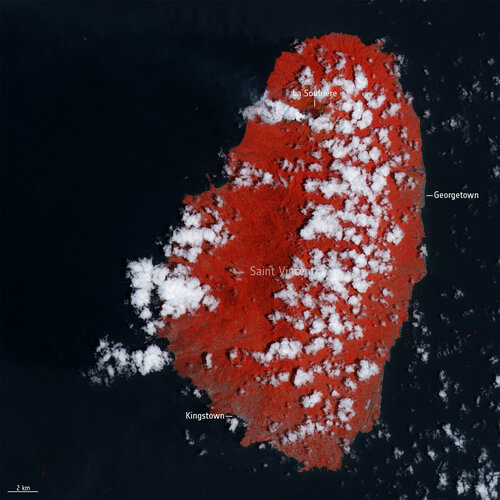 Image:
False-colour images captured by Copernicus Sentinel-2 show the aftermath of the explosive volcanic eruption that took place on 9 April 2021 on the Caribbean island of Saint Vincent.
Image:
False-colour images captured by Copernicus Sentinel-2 show the aftermath of the explosive volcanic eruption that took place on 9 April 2021 on the Caribbean island of Saint Vincent.
Welcome to the Space Crossroads, where space and great ideas meet
16.4.2021 12:38 European GNSS Agency
The European GNSS Agency (GSA) is launching the Space Crossroads, a series of online broadcasts where we will discuss how space is inspiring entrepreneurs and start-ups, enabling new ideas to scale up. The series will feature contributions from industry leaders, experts, investors and big players, who will share their space experience. The format will also allow for Q&As and networking opportunities. Sounds intriguing? Then see you at our first Space Crossroads!
On Thursday 22 April, the GSA will kick off the Space Crossroads, a series dedicated to the people and businesses whose paths keep crossing with space, to discuss how this this interaction is enabling the creation of innovative ideas and new businesses and start-ups.
So, what has inspired the Space Crossroads? Well, in recent years, the GSA has attracted over 600 EU start-ups to participate in the MyGalileoApp, MyGalileoSolution, MyGalileoDrone and other competitions and hackathons. However, winning a competition is only the beginning of a steep learning curve. Ensuring stable revenue is the ultimate dream of all start-ups, and nothing is more important than networking when it comes to getting the first customers on board!
Through the Space Crossroads, the GSA intends to connect start-ups and entrepreneurs with leaders, experts, investors and big players, creating a supportive environment where new ideas can flourish and move closer to market. Every episode will present exciting new guests and topics. The setting is informal, so grab a coffee and relax in the cosy virtual corner that we have created, where you can interact with speakers and participants.
Sharing best practices
The Space Crossroads series offers a platform where a virtual community of GSA-incubated start-ups and entrepreneurs can share experiences and best practices to help new ideas and innovation thrive. In the series, GSA start-ups and others can meet, ask questions, receive feedback, learn from each other and make valuable connections.
Read this: Galileo means business for SMEs and start-ups!
The Space Crossroads community consist of two different channels, a Slack group where members can exchange information at any time; and a series of virtual webcasts organized every other Thursday by the GSA with the contribution of a rich line up of guests. The Slack group, which will be moderated by the GSA, will be the place to ask questions and share experiences.
Topic focused
The series will be available to registered Space Crossroads members, every week you will receive in your inbox a link to the agenda of the next meeting and a log-in to the webcast. The webcasts are chaired by the GSA and feature a calendar of topics and guests, creating a virtual crossroads where ideas and people meet and travel on to new horizons. The registration will be soon available on this page.
The topics and dates of the first four webcasts are:
- How to step up your game and start playing with the big kids: April 22, 16:00-17:00
- Receivers: the heart of GNSS solutions: May 6, 16:00-17:00
- Start-up 101: writing a success story: May 20, 16:00-17:00
- The top 10 mistakes in B2B sales: 3 June, 16:00-17:00
To see the full draft programme of upcoming webcasts, click here.
Sneak peek
In the first episode we will start strong to finish even stronger. We will address the elephant in the room for every start-up: how start-ups and young entrepreneurs can get their foot in the door of big companies and create opportunities for cooperation, and how to market and pitch to large corporations.
We will discuss these and other points with our first guest: Ed Parsons from Google. Ed Parsons is a Geospatial Technologist at Google, a member of the Board of Directors of the Open Geospatial Consortium, a Visiting Professor at University College London and, previously, a successful entrepreneur. Join us next Thursday, 22 April, to learn more!
The webcasts will be available through a webex link. Mark your calendars, this is something you certainly do not want to miss!
Media note: This feature can be republished without charge provided the European GNSS Agency (GSA) is acknowledged as the source at the top or the bottom of the story. You must request permission before you use any of the photographs on the site. If you republish, we would be grateful if you could link back to the GSA website (http://www.gsa.europa.eu).
Welcome to the Space Crossroads, where space and great ideas meet
16.4.2021 12:38 European GNSS Agency
The European GNSS Agency (GSA) is launching the Space Crossroads, a series of online broadcasts where we will discuss how space is inspiring entrepreneurs and start-ups, enabling new ideas to scale up. The series will feature contributions from industry leaders, experts, investors and big players, who will share their space experience. The format will also allow for Q&As and networking opportunities. Sounds intriguing? Then see you at our first Space Crossroads!
On Thursday 22 April, the GSA will kick off the Space Crossroads, a series dedicated to the people and businesses whose paths keep crossing with space, to discuss how this this interaction is enabling the creation of innovative ideas and new businesses and start-ups.
So, what has inspired the Space Crossroads? Well, in recent years, the GSA has attracted over 600 EU start-ups to participate in the MyGalileoApp, MyGalileoSolution, MyGalileoDrone and other competitions and hackathons. However, winning a competition is only the beginning of a steep learning curve. Ensuring stable revenue is the ultimate dream of all start-ups, and nothing is more important than networking when it comes to getting the first customers on board!
Through the Space Crossroads, the GSA intends to connect start-ups and entrepreneurs with leaders, experts, investors and big players, creating a supportive environment where new ideas can flourish and move closer to market. Every episode will present exciting new guests and topics. The setting is informal, so grab a coffee and relax in the cosy virtual corner that we have created, where you can interact with speakers and participants.
Sharing best practices
The Space Crossroads series offers a platform where a virtual community of GSA-incubated start-ups and entrepreneurs can share experiences and best practices to help new ideas and innovation thrive. In the series, GSA start-ups and others can meet, ask questions, receive feedback, learn from each other and make valuable connections.
Read this: Galileo means business for SMEs and start-ups!
The Space Crossroads community consist of two different channels, a Slack group where members can exchange information at any time; and a series of virtual webcasts organized every other Thursday by the GSA with the contribution of a rich line up of guests. The Slack group, which will be moderated by the GSA, will be the place to ask questions and share experiences.
Topic focused
The series will be available to registered Space Crossroads members, every week you will receive in your inbox a link to the agenda of the next meeting and a log-in to the webcast. The webcasts are chaired by the GSA and feature a calendar of topics and guests, creating a virtual crossroads where ideas and people meet and travel on to new horizons. The registration will be soon available on this page.
The topics and dates of the first four webcasts are:
- How to step up your game and start playing with the big kids: April 22, 16:00-17:00
- Receivers: the heart of GNSS solutions: May 6, 16:00-17:00
- Start-up 101: writing a success story: May 20, 16:00-17:00
- The top 10 mistakes in B2B sales: 3 June, 16:00-17:00
To see the full draft programme of upcoming webcasts, click here.
Sneak peek
In the first episode we will start strong to finish even stronger. We will address the elephant in the room for every start-up: how start-ups and young entrepreneurs can get their foot in the door of big companies and create opportunities for cooperation, and how to market and pitch to large corporations.
We will discuss these and other points with our first guest: Ed Parsons from Google. Ed Parsons is a Geospatial Technologist at Google, a member of the Board of Directors of the Open Geospatial Consortium, a Visiting Professor at University College London and, previously, a successful entrepreneur. Join us next Thursday, 22 April, to learn more!
The webcasts will be available through a webex link. Mark your calendars, this is something you certainly do not want to miss!
Media note: This feature can be republished without charge provided the European GNSS Agency (GSA) is acknowledged as the source at the top or the bottom of the story. You must request permission before you use any of the photographs on the site. If you republish, we would be grateful if you could link back to the GSA website (http://www.gsa.europa.eu).
Welcome to the Space Crossroads, where space and great ideas meet
16.4.2021 12:38 European GNSS Agency
The European GNSS Agency (GSA) is launching the Space Crossroads, a series of online broadcasts where we will discuss how space is inspiring entrepreneurs and start-ups, enabling new ideas to scale up. The series will feature contributions from industry leaders, experts, investors and big players, who will share their space experience. The format will also allow for Q&As and networking opportunities. Sounds intriguing? Then see you at our first Space Crossroads!
On Thursday 22 April, the GSA will kick off the Space Crossroads, a series dedicated to the people and businesses whose paths keep crossing with space, to discuss how this interaction is enabling the creation of innovative ideas and new businesses and start-ups.
So, what has inspired the Space Crossroads? Well, in recent years, the GSA has attracted over 600 EU start-ups to participate in the MyGalileoApp, MyGalileoSolution, MyGalileoDrone and other competitions and hackathons. However, winning a competition is only the beginning of a steep learning curve. Ensuring stable revenue is the ultimate dream of all start-ups, and nothing is more important than networking when it comes to getting the first customers on board!
Through the Space Crossroads, the GSA intends to connect start-ups and entrepreneurs with leaders, experts, investors and big players, creating a supportive environment where new ideas can flourish and move closer to market. Every episode will present exciting new guests and topics. The setting is informal, so grab a coffee and relax in the cosy virtual corner that we have created, where you can interact with speakers and participants.
Sharing best practices
The Space Crossroads series offers a platform where a virtual community of GSA-incubated start-ups and entrepreneurs can share experiences and best practices to help new ideas and innovation thrive. In the series, GSA start-ups and others can meet, ask questions, receive feedback, learn from each other and make valuable connections.
Read this: Galileo means business for SMEs and start-ups!
The Space Crossroads community consist of two different channels, a Slack group where members can exchange information at any time; and a series of virtual webcasts organized every other Thursday by the GSA with the contribution of a rich line up of guests. The Slack group, which will be moderated by the GSA, will be the place to ask questions and share experiences.
Topic focused
The series will be available to registered Space Crossroads members, every week you will receive in your inbox a link to the agenda of the next meeting and a log-in to the webcast. The webcasts are chaired by the GSA and feature a calendar of topics and guests, creating a virtual crossroads where ideas and people meet and travel on to new horizons. The registration will be soon available on this page.
The topics and dates of the first four webcasts are:
- How to step up your game and start playing with the big kids: April 22, 16:00-17:00
- Receivers: the heart of GNSS solutions: May 6, 16:00-17:00
- Start-up 101: writing a success story: May 20, 16:00-17:00
- The top 10 mistakes in B2B sales: 3 June, 16:00-17:00
To see the full draft programme of upcoming webcasts, click here.
Sneak peek
In the first episode we will start strong to finish even stronger. We will address the elephant in the room for every start-up: how start-ups and young entrepreneurs can get their foot in the door of big companies and create opportunities for cooperation, and how to market and pitch to large corporations.
We will discuss these and other points with our first guest: Ed Parsons from Google. Ed Parsons is a Geospatial Technologist at Google, a member of the Board of Directors of the Open Geospatial Consortium, a Visiting Professor at University College London and, previously, a successful entrepreneur. Join us next Thursday, 22 April, to learn more!
The webcasts will be available through a webex link. Mark your calendars, this is something you certainly do not want to miss!
Media note: This feature can be republished without charge provided the European GNSS Agency (GSA) is acknowledged as the source at the top or the bottom of the story. You must request permission before you use any of the photographs on the site. If you republish, we would be grateful if you could link back to the GSA website (http://www.gsa.europa.eu).
Welcome to the Space Crossroads, where space and great ideas meet
16.4.2021 12:38 European GNSS Agency
The European GNSS Agency (GSA) is launching the Space Crossroads, a series of online broadcasts where we will discuss how space is inspiring entrepreneurs and start-ups, enabling new ideas to scale up. The series will feature contributions from industry leaders, experts, investors and big players, who will share their space experience. The format will also allow for Q&As and networking opportunities. Sounds intriguing? Then see you at our first Space Crossroads!
On Thursday 22 April, the GSA will kick off the Space Crossroads, a series dedicated to the people and businesses whose paths keep crossing with space, to discuss how this interaction is enabling the creation of innovative ideas and new businesses and start-ups.
So, what has inspired the Space Crossroads? Well, in recent years, the GSA has attracted over 600 EU start-ups to participate in the MyGalileoApp, MyGalileoSolution, MyGalileoDrone and other competitions and hackathons. However, winning a competition is only the beginning of a steep learning curve. Ensuring stable revenue is the ultimate dream of all start-ups, and nothing is more important than networking when it comes to getting the first customers on board!
Through the Space Crossroads, the GSA intends to connect start-ups and entrepreneurs with leaders, experts, investors and big players, creating a supportive environment where new ideas can flourish and move closer to market. Every episode will present exciting new guests and topics. The setting is informal, so grab a coffee and relax in the cosy virtual corner that we have created, where you can interact with speakers and participants.
Sharing best practices
The Space Crossroads series offers a platform where a virtual community of GSA-incubated start-ups and entrepreneurs can share experiences and best practices to help new ideas and innovation thrive. In the series, GSA start-ups and others can meet, ask questions, receive feedback, learn from each other and make valuable connections.
Read this: Galileo means business for SMEs and start-ups!
The Space Crossroads community consist of two different channels, a Slack group where members can exchange information at any time; and a series of virtual webcasts organized every other Thursday by the GSA with the contribution of a rich line up of guests. The Slack group, which will be moderated by the GSA, will be the place to ask questions and share experiences.
Topic focused
The series will be available to registered Space Crossroads members, every week you will receive in your inbox a link to the agenda of the next meeting and a log-in to the webcast. The webcasts are chaired by the GSA and feature a calendar of topics and guests, creating a virtual crossroads where ideas and people meet and travel on to new horizons. The registration will be soon available on this page.
The topics and dates of the first four webcasts are:
- How to step up your game and start playing with the big kids: April 22, 16:00-17:00
- Receivers: the heart of GNSS solutions: May 6, 16:00-17:00
- Start-up 101: writing a success story: May 20, 16:00-17:00
- The top 10 mistakes in B2B sales: 3 June, 16:00-17:00
To see the full draft programme of upcoming webcasts, click here.
Sneak peek
In the first episode we will start strong to finish even stronger. We will address the elephant in the room for every start-up: how start-ups and young entrepreneurs can get their foot in the door of big companies and create opportunities for cooperation, and how to market and pitch to large corporations.
We will discuss these and other points with our first guest: Ed Parsons from Google. Ed Parsons is a Geospatial Technologist at Google, a member of the Board of Directors of the Open Geospatial Consortium, a Visiting Professor at University College London and, previously, a successful entrepreneur. Join us next Thursday, 22 April, to learn more!
The webcasts will be available through a webex link. Mark your calendars, this is something you certainly do not want to miss!
Media note: This feature can be republished without charge provided the European GNSS Agency (GSA) is acknowledged as the source at the top or the bottom of the story. You must request permission before you use any of the photographs on the site. If you republish, we would be grateful if you could link back to the GSA website (http://www.gsa.europa.eu).
rada/odborný rada – návrh zápisu, kontrola a zplatnění
16.4.2021 12:37 ČÚZK - předpisy a opatření Katastrální úřad pro hlavní město Prahu Katastrální pracoviště Prahavypisuje výběrové řízení na místo
rada/odborný rada – návrh zápisu, kontrola a zplatnění
rada/odborný rada – návrh zápisu, kontrola a zplatnění
16.4.2021 12:37 ČÚZK - volná místa Katastrální úřad pro hlavní město Prahu Katastrální pracoviště Praha vypisuje výběrové řízení na místo rada/odborný rada – návrh zápisu, kontrola a zplatněníVR do 01.07.2021 referent KN – zápis do protokolu řízení V a Z
16.4.2021 12:30 ČÚZK /Urady/Katastralni-urady/Katastralni-urady/Katastralni-urad-pro-hlavni-mesto-Prahu/O-uradu/Aktuality/Volna-mista-16-04-2021VR do 01.07.2021 referent KN – zápis do protokolu řízení V a Z v PO IV
16.4.2021 12:30 ČÚZK - předpisy a opatření Katastrální úřad pro hlavní město Prahu zveřejnil novou aktualitu: Ředitelka úřadu vyhlašuje výběrové řízení na služební místo:referent KN – zápis do protokolu řízení V a Z v PO IV
Volná místa 16.04.2021
16.4.2021 12:30 ČÚZK /Urady/Katastralni-urady/Katastralni-urady/Katastralni-urad-pro-hlavni-mesto-Prahu/O-uradu/Aktuality/Volna-mista-16-04-2021Volná místa 16.04.2021
16.4.2021 12:30 ČÚZK - předpisy a opatření Katastrální úřad pro hlavní město Prahu - Katastrální pracoviště Praha zveřejnil novou aktualitu: Ředitel úřadu vyhlašuje výběrové řízení na služební místo:rada/odborný rada – návrh zápisu, kontrola a zplatnění
Volná místa 19.04.2021 (pracovník podatelny)
16.4.2021 12:30 ČÚZK /Urady/Katastralni-urady/Katastralni-urady/Katastralni-urad-pro-hlavni-mesto-Prahu/O-uradu/Aktuality/Volna-mista-16-04-2021VR do 18.08.2021 vrchní referent/rada – kontrola listin určených k záznamu
16.4.2021 12:30 ČÚZK /Urady/Katastralni-urady/Katastralni-urady/Katastralni-urad-pro-hlavni-mesto-Prahu/O-uradu/Aktuality/Volna-mista-16-04-2021VR do 01.07.2021 referent KN – zápis do protokolu řízení V a Z v PO IV
16.4.2021 12:30 ČÚZK /Urady/Katastralni-urady/Katastralni-urady/Katastralni-urad-pro-hlavni-mesto-Prahu/O-uradu/Aktuality/Volna-mista-16-04-2021Volná místa 16.04.2021
16.4.2021 12:30 ČÚZK - předpisy a opatření Katastrální úřad pro hlavní město Prahu - Katastrální pracoviště Praha zveřejnil novou aktualitu: Ředitel úřadu vyhlašuje výběrové řízení na služební místo:rada/odborný rada – návrh zápisu, kontrola a zplatnění
VM do 19.05.2021 (pracovník podatelny)
16.4.2021 12:30 ČÚZK /Urady/Katastralni-urady/Katastralni-urady/Katastralni-urad-pro-hlavni-mesto-Prahu/O-uradu/Aktuality/Volna-mista-16-04-2021Volná místa 19.04.2021 (pracovník podatelny)
16.4.2021 12:30 ČÚZK - předpisy a opatření Katastrální úřad pro hlavní město Prahu zveřejnil novou aktualitu: Ředitel úřadu vyhlašuje výběrové řízení na služební místo:pracovník podatelny
VM do 19.05.2021 (pracovník podatelny)
16.4.2021 12:30 ČÚZK - předpisy a opatření Katastrální úřad pro hlavní město Prahu zveřejnil novou aktualitu: Ředitelka úřadu vyhlašuje výběrové řízení na služební místo:pracovník podatelny
VR do 18.08.2021 vrchní referent/rada – kontrola listin určených k záznamu
16.4.2021 12:30 ČÚZK - předpisy a opatření Katastrální úřad pro hlavní město Prahu - Katastrální pracoviště Praha zveřejnil novou aktualitu: Ředitelka úřadu vyhlašuje výběrové řízení na služební místo:vrchní referent/rada – kontrola listin určených k záznamu
VR do 01.07.2021 referent KN – zápis do protokolu řízení V a Z
16.4.2021 12:30 ČÚZK - předpisy a opatření Katastrální úřad pro hlavní město Prahu zveřejnil novou aktualitu: Ředitelka úřadu vyhlašuje výběrové řízení na služební místo:referent KN – zápis do protokolu řízení V a Z
rada/odborný rada – návrh zápisu, kontrola a zplatnění
16.4.2021 12:25 ČÚZK - volná místa Katastrální úřad pro hlavní město Prahu Katastrální pracoviště Praha vypisuje výběrové řízení na místo rada/odborný rada – návrh zápisu, kontrola a zplatnění20210416_Vrchní referent / rada oddělení právních vztahů k nemovitostem
16.4.2021 11:09 ČÚZK /Urady/Katastralni-urady/Katastralni-urady/Katastralni-urad-pro-Stredocesky-kraj/Katastralni-pracoviste/KP-Benesov/O-uradu/Aktuality/20210113_odborny-rada,-reditel-Katastralniho-p-(4)20210416_Odborný rada oddělení právních vztahů k nemovitostem 02
16.4.2021 11:09 ČÚZK /Urady/Katastralni-urady/Katastralni-urady/Katastralni-urad-pro-Stredocesky-kraj/Katastralni-pracoviste/KP-Benesov/O-uradu/Aktuality/20210113_odborny-rada,-reditel-Katastralniho-p-(4)20210416_Vrchní referent / rada oddělení právních vztahů k nemovitostem
16.4.2021 11:09 ČÚZK - předpisy a opatření Katastrální úřad pro Středočeský kraj - Katastrální pracoviště Benešov Vyhlášení výběrového řízení: Vrchní referent / rada oddělení právních vztahů k nemovitostem V části "Úřední deska", v sekci "Oznámení a jiná úřední sdělení" bylo vystaveno "Oznámení o vyhlášení výběrového řízení na obsazení služebního místa Vrchní referent / rada oddělení právních vztahů k nemovitostem"Vrchní referent / rada oddělení právních vztahů k nemovitostem
16.4.2021 11:08 ČÚZK - předpisy a opatření Katastrální úřad pro Středočeský kraj - Katastrální pracoviště Benešovvypisuje výběrové řízení na místo Vrchní referent / rada oddělení právních vztahů k nemovitostem
Vrchní referent / rada oddělení právních vztahů k nemovitostem
Vrchní referent / rada oddělení právních vztahů k nemovitostem
16.4.2021 11:08 ČÚZK - volná místa Katastrální úřad pro Středočeský kraj - Katastrální pracoviště Benešov vypisuje výběrové řízení na místo Vrchní referent / rada oddělení právních vztahů k nemovitostemVrchní referent / rada oddělení právních vztahů k nemovitostem
16.4.2021 11:08 ČÚZK /Urady/Katastralni-urady/Katastralni-urady/Katastralni-urad-pro-Stredocesky-kraj/Uredni-deska/Oznameni-a-jina-uredni-sdeleni/Volna-mista/Vrchni-referent-rada-oddeleni-pravnich-vztahu-(1)Upozornění 8.11.2021
16.4.2021 11:07 ČÚZK - předpisy a opatření Zeměměřický a katastrální inspektorát v Opavě zveřejnil novou aktualitu: S ohledem na epidemickou situaci je i nadále upřednostňován písemný, elektronický či telefonický kontakt před osobním ve všech případech, kdy je to možné.Děkujeme za pochopení
Upozornění 8.11.2021
16.4.2021 11:07 ČÚZK /Urady/Zememericke-a-katastralni-inspektoraty/Zememericke-a-katastralni-inspektoraty/Zememericky-a-katastralni-inspektorat-v-Opave/O-uradu/Aktuality/Upozorneni-16-4-2021Upozornění 16.4.2021
16.4.2021 11:07 ČÚZK - předpisy a opatření Zeměměřický a katastrální inspektorát v Opavě zveřejnil novou aktualitu: S ohledem na epidemickou situaci je i nadále upřednostňován písemný, elektronický či telefonický kontakt před osobním ve všech případech, kdy je to možné.Děkujeme za pochopení
Upozornění 16.4.2021
16.4.2021 11:07 ČÚZK /Urady/Zememericke-a-katastralni-inspektoraty/Zememericke-a-katastralni-inspektoraty/Zememericky-a-katastralni-inspektorat-v-Opave/O-uradu/Aktuality/Upozorneni-16-4-202120210416_Odborný rada oddělení právních vztahů k nemovitostem 02
16.4.2021 10:45 ČÚZK - předpisy a opatření Katastrální úřad pro Středočeský kraj - Katastrální pracoviště Benešov Vyhlášení výběrového řízení: Odborný rada oddělení právních vztahů k nemovitostem 02 V části "Úřední deska", v sekci "Oznámení a jiná úřední sdělení" bylo vystaveno "Oznámení o vyhlášení výběrového řízení na obsazení služebního místa Odborný rada oddělení právních vztahů k nemovitostem 02"20210416_Odborný rada oddělení právních vztahů k nemovitostem 02
16.4.2021 10:45 ČÚZK /Urady/Katastralni-urady/Katastralni-urady/Katastralni-urad-pro-Stredocesky-kraj/Katastralni-pracoviste/KP-Benesov/O-uradu/Aktuality/20210113_odborny-rada,-reditel-Katastralniho-p-(2)Odborný rada oddělení právních vztahů k nemovitostem 02
16.4.2021 10:42 ČÚZK - volná místa Katastrální úřad pro Středočeský kraj - Katastrální pracoviště Benešov vypisuje výběrové řízení na místo Odborný rada oddělení právních vztahů k nemovitostem 02Odborný rada oddělení právních vztahů k nemovitostem 02
16.4.2021 10:42 ČÚZK /Urady/Katastralni-urady/Katastralni-urady/Katastralni-urad-pro-Stredocesky-kraj/Uredni-deska/Oznameni-a-jina-uredni-sdeleni/Volna-mista/Odborny-rada-oddeleni-pravnich-vztahu-k-nemovi-(3)Odborný rada oddělení právních vztahů k nemovitostem 02
16.4.2021 10:42 ČÚZK - předpisy a opatření Katastrální úřad pro Středočeský kraj - Katastrální pracoviště Benešovvypisuje výběrové řízení na místo Odborný rada oddělení právních vztahů k nemovitostem 02
Odborný rada oddělení právních vztahů k nemovitostem 02
20210416_Odborný rada oddělení právních vztahů k nemovitostem
16.4.2021 10:26 ČÚZK /Urady/Katastralni-urady/Katastralni-urady/Katastralni-urad-pro-Stredocesky-kraj/Katastralni-pracoviste/KP-Benesov/O-uradu/Aktuality/20210113_odborny-rada,-reditel-Katastralniho-p-(1)20210416_Odborný rada oddělení právních vztahů k nemovitostem
16.4.2021 10:26 ČÚZK - předpisy a opatření Katastrální úřad pro Středočeský kraj - Katastrální pracoviště Benešov Vyhlášení výběrového řízení: Odborný rada oddělení právních vztahů k nemovitostem V části "Úřední deska", v sekci "Oznámení a jiná úřední sdělení" bylo vystaveno "Oznámení o vyhlášení výběrového řízení na obsazení služebního místa Odborný rada oddělení právních vztahů k nemovitostem"Odborný rada oddělení právních vztahů k nemovitostem 01
16.4.2021 10:20 ČÚZK /Urady/Katastralni-urady/Katastralni-urady/Katastralni-urad-pro-Stredocesky-kraj/Uredni-deska/Oznameni-a-jina-uredni-sdeleni/Volna-mista/Odborny-rada-oddeleni-pravnich-vztahu-k-nemovi-(2)Odborný rada oddělení právních vztahů k nemovitostem 01
16.4.2021 10:20 ČÚZK - předpisy a opatření Katastrální úřad pro Středočeský kraj - Katastrální pracoviště Benešovvypisuje výběrové řízení na místo Odborný rada oddělení právních vztahů k nemovitostem 01
Odborný rada oddělení právních vztahů k nemovitostem 01
Odborný rada oddělení právních vztahů k nemovitostem
16.4.2021 10:20 ČÚZK /Urady/Katastralni-urady/Katastralni-urady/Katastralni-urad-pro-Stredocesky-kraj/Uredni-deska/Oznameni-a-jina-uredni-sdeleni/Volna-mista/Odborny-rada-oddeleni-pravnich-vztahu-k-nemovi-(2)Odborný rada oddělení právních vztahů k nemovitostem
16.4.2021 10:20 ČÚZK - předpisy a opatření Katastrální úřad pro Středočeský kraj - Katastrální pracoviště Benešovvypisuje výběrové řízení na místo Odborný rada oddělení právních vztahů k nemovitostem
Odborný rada oddělení právních vztahů k nemovitostem
Odborný rada oddělení právních vztahů k nemovitostem
16.4.2021 10:20 ČÚZK - volná místa Katastrální úřad pro Středočeský kraj - Katastrální pracoviště Benešov vypisuje výběrové řízení na místo Odborný rada oddělení právních vztahů k nemovitostemOdborný rada oddělení právních vztahů k nemovitostem 01
16.4.2021 10:20 ČÚZK - volná místa Katastrální úřad pro Středočeský kraj - Katastrální pracoviště Benešov vypisuje výběrové řízení na místo Odborný rada oddělení právních vztahů k nemovitostem 01Earth from Space: Space Coast, Florida
16.4.2021 10:00 ESA Observing the Earth
On 22 April 2021, on Earth Day, Thomas Pesquet is planned to return to the International Space Station for his second mission, Alpha. Ahead of his launch, the Copernicus Sentinel-2 mission takes us over Cape Canaveral, USA, in a region known as the Space Coast.
Earth from Space: Space Coast, Florida
16.4.2021 10:00 ESA Observing the Earth
On 22 April 2021, on Earth Day, Thomas Pesquet is planned to return to the International Space Station for his second mission, Alpha. Ahead of his launch, the Copernicus Sentinel-2 mission takes us over Cape Canaveral, USA, in a region known as the Space Coast.
I vy můžete být součástí Esri UC 2021
16.4.2021 9:52 ARCDATASvětová konference Esri bude i letos probíhat virtuální formou a bude zdarma přístupná pro všechny uživatele Esri s platnou systémovou podporou (maintenance). Tato konference je největším oborovým setkáním geoinformatiků na světě a je takřka nevyčerpatelným zdrojem inspirace v GIS.
Vaše obrázky v prezentaci Jacka Dangermonda
Představte svoji práci uživatelům ArcGIS z celého světa – zasílejte obrázky do Plenary sekce prostřednictvím formuláře do 3. června 2021.
Přehlídka map a aplikací
Prostřednictvím tohoto formuláře můžete i vy poslat do soutěžní přehlídky svoji mapu nebo aplikaci. Mapy v přehlídce mohou hodnotit všichni účastníci konference a vítězové získají ocenění People's Choice Award. Termín pro zaslání map do virtuální galerie je stanoven na 4. června 2021. V loňském roce se takto na konferenci prezentovala například Masarykova univerzita nebo Česká geologická služba.
Registrace
Na konferenci se již můžete hlásit přímo na stránkách Esri UC, kde se stačí zaregistrovat svým účtem Esri.
Bluesky MetroVista Mesh Models Underpin Dynamic Map of London
16.4.2021 9:00 GISCafe.com Webcasts-Webinars Leicestershire, UK, 13 April 2021 - Photorealistic 3D models from Bluesky are being used to produce a new interactive map of London. Created by the …New tech from Maptek to uncork geology bottleneck
16.4.2021 9:00 GISCafe.com Webcasts-Webinars Machine learning combined with cloud computing is destined to free up the geological supply chain to allow businesses to better leverage a key asset …US Army Geospatial Center Upgrades OGC Membership to Advance Open Systems
16.4.2021 9:00 GISCafe.com Webcasts-Webinars AGC’s new level of OGC membership supports advancing standards for cross-system interoperability and geospatial information …
Maxar Technologies First Quarter 2021 Investor Call Scheduled for Monday, May 3, 2021
16.4.2021 9:00 GISCafe.com Webcasts-Webinars WESTMINSTER, Colo. — (BUSINESS WIRE) — April 14, 2021 — Maxar Technologies (NYSE:MAXR) (TSX:MAXR), a trusted partner and innovator …GaKO 4/2021
16.4.2021 6:27 GaKO GaKO 4/2021 MACKOVČIN, P.: Německé vojenské mapy československé části Slezska z let 1936–1945Odborný referent v oddělení právních vztahů k nemovitostem na Katastrálním pracovišti Znojmo
16.4.2021 5:50 ČÚZK - volná místa Katastrální úřad pro Jihomoravský kraj Katastrální pracoviště Znojmo vypisuje výběrové řízení na místo Odborný referent v oddělení právních vztahů k nemovitostem na Katastrálním pracovišti ZnojmoOdborný referent v oddělení právních vztahů k nemovitostem na Katastrálním pracovišti Znojmo
16.4.2021 5:50 ČÚZK - předpisy a opatření Katastrální úřad pro Jihomoravský kraj Katastrální pracoviště Znojmovypisuje výběrové řízení na místo
Odborný referent v oddělení právních vztahů k nemovitostem na Katastrálním pracovišti Znojmo
Odborný referent v oddělení právních vztahů k nemovitostem na Katastrálním pracovišti Znojmo
16.4.2021 5:50 ČÚZK /Urady/Katastralni-urady/Katastralni-urady/Katastralni-urad-pro-Jihomoravsky-kraj/Volna-mista/DMS/Odborny-referent-v-oddeleni-pravnich-vztahu-k-nemoDAEX DESIGN Professional v akční nabídce
15.4.2021 21:03 ŠPINAR - software Vážení zákazníci,v akční nabídce nyní můžete získat náš nejsilnější program pro navrhování nábytku a interiérů DAEX Professional.
DAEX DESIGN Professional v akční nabídce
15.4.2021 21:03 ŠPINAR - softwareVážení zákazníci,
v akční nabídce nyní můžete získat náš nejsilnější program pro navrhování nábytku a interiérů DAEX Professional.
The post DAEX DESIGN Professional v akční nabídce appeared first on ŠPINAR – software.
DAEX DESIGN Professional v akční nabídce
15.4.2021 21:03 ŠPINAR - softwareVážení zákazníci,
v akční nabídce nyní můžete získat náš nejsilnější program pro navrhování nábytku a interiérů DAEX Professional.
The post DAEX DESIGN Professional v akční nabídce appeared first on ŠPINAR – software.
USGIF Announces 2021 Lifetime Achievement Award Recipient
15.4.2021 20:27 GISCafe.com Webcasts-Webinars Stu Shea will receive the Arthur C. Lundahl-Thomas C. Finnie Lifetime Achievement Award at USGIF’s GEOGala Dec. 3.Herndon, Virginia (April …
Drone Nerds Announces the Launch of the DJI Air 2S
15.4.2021 19:26 GISCafe.com Webcasts-Webinars Florida, April 15, 2021 (GLOBE NEWSWIRE) -- Drone Nerds, the company with the largest inventory of drones and accessories in the U.S., today …DJI Air 2S Melds Incredible Image Quality With Unmatched Flight Performance
15.4.2021 16:15 GISCafe.com Webcasts-Webinars NEW YORK, April 15, 2021 — (PRNewswire) — DJI, the global leader in civilian drones and creative camera technology, …Carbon Mapper Launches Satellite Program to Pinpoint Methane and Carbon Dioxide Super Emitters
15.4.2021 16:15 GISCafe.com Webcasts-Webinars SAN FRANCISCO, April 15, 2021 — (PRNewswire) — Carbon Mapper, a new nonprofit organization, and its partners - the State of …ZeroEyes Announces Phase I SBIR Award from the Department of Defense to Develop Drone-Enabled Active Shooter Deterrence Capabilities
15.4.2021 16:15 GISCafe.com Webcasts-Webinars PHILADELPHIA, April 15, 2021 — (PRNewswire) — ZeroEyes, Inc. is pleased to announce an AFWERX Phase 1 Small Business Innovation Research …Satellite imagery key to powering Google Earth
15.4.2021 15:00 ESA Observing the Earth
One of the most comprehensive pictures of our changing planet is now available to the public. Thanks to the close collaboration between Google Earth, ESA, the European Commission, NASA and the US Geological Survey, 24 million satellite photos from the past 37 years have been embedded into a new layer of Google Earth – creating a new, explorable view of time on our planet.
Jaké jsou novinky v ArcGIS Online?
15.4.2021 9:47 ARCDATAJe tu pravidelná jarní aktualizace prostředí ArcGIS Online. S některými nejvýznamnějšími změnami vás seznámíme v tomto článku.
Spolupráce mezi organizacemi
S touto aktualizací ArcGIS Online přichází velmi očekáváná možnost spolupráce mezi dvěma nebo více organizacemi v rámci ArcGIS Online a doplňuje tak dřívější způsoby spolupráce mezi organizacemi ArcGIS Online a ArcGIS Enterprise, nebo mezi dvěma organizacemi s ArcGIS Enterprise. Podařilo se zefektivnit i správu skupin – koordinátoři ze zastupujících organizací mohou přidávat členy ze své vnitřní organizace do společné skupiny, kde mohou společně vytvářet mapy, aplikace nebo třeba společně sdílet aktualizace.
Aby byl proces sdílení obsahu napříč organizacemi bezpečný, je možné tento sdílený obsah omezit jen pro vybranou skupinu členů ze zastoupených organizací.
Novinky v prohlížeči map
Přichází také nová generace mapového prohlížeče, jehož beta verzi jste už určitě zaznamenali v některém z předchozích článků či videí. Novou verzi může nastavit jako výchozí mapový prohlížeč správce dané organizace, případně si jej mohou vybrat sami uživatelé v rámci uživatelského nastavení. Předchozí verze této aplikace bude zatím stále k dispozici pod názvem MapViewer Classic.
Kromě všech stávajících funkcí z beta verze přináší nový mapový prohlížeč další vylepšení v oblasti vizualizace dat (smart mapping), podporu grafů, možnost rychlé publikace aplikací (dashboardů, map s příběhem, šablonových aplikací) a další.
Vedle toho je nyní možné během úprav pohodlně přepínat mezi jednotlivými vrstvami a pro zobrazení mapy využívat režimu celé obrazovky.
ArcGIS Dashboards
ArcGIS Dashboards vycházející z ArcGIS API for JavaScript 4.x také opouštějí označení beta verze a stávají se oficiální. ArcGIS Dashboards dokážou využívat nový mapový prohlížeč včetně víceprvkových pop-up oken. Další významnou novinkou, kterou v nových Dashboards určitě nevynechejte, je podpora jazyka Arcade u vybraných widgetů.
Předchozí verze ArcGIS Dashboards je stále k dispozici, pouze s tím rozdílem, že je přejmenována na ArcGIS Dashboards Classic. Znamená to, že i nadále je možné spustit či upravit již stávající dashboardy ve starší verzi, avšak doporučujeme je zaktualizovat na novou verzi. Starší verze těchto aplikací by však měly fungovat i v této nové verzi ArcGIS Dashboards.
ArcGIS Notebooks
ArcGIS Notebooks je prostředí pro spouštění skriptů v jazyku Python, jehož prostřednictvím můžete provádět jak správu organizace, tak spouštění analytických nástrojů.
Nespornou výhodou ArcGIS Notebooks je možnost psát v nich kód, tento postup dokumentovat a současně jej i spouštět. Vše se odehrává v okně webového prohlížeče, kde se jednotlivé příkazy ukládají, můžeme se k nim vracet, upravovat je a spouštět v libovolném pořadí.
Od dubna 2021 je v rámci ArcGIS Notebooks možné rutinní úlohy i automatizovat. Vedle toho lze nastavit automatizovanou úlohuna stanovený čas anebo nastavit její opakování. Kromě plánování je možné i pořízení snapshotu notebooku – funkce je v nabídce v hlavním toolbaru.
Je však třeba mít na paměti, že pro přesné plánování úloh v ArcGIS Notebooks je třeba disponovat patřičnou rolí v systému.
Novinky na domovské stránce
Vedle možnosti vybrat si jedno z osmi přednastavených barevných schémat domovské stránky organizace, je nyní také možné přizpůsobit si barevné schéma a využívat vlastní nastavení stylů. Díky tomu lze vytvořit unikátní motivy barev tak, aby odpovídaly pravidlům a vizuální identitě dané organizace.
ArcGIS Experience Builder
Během dubnové aktualizace přichází i ArcGIS Experience Builder s několika novými funkcemi. Jde především o nabídku widgetů (Query, Coordinate Convertion). Vedle toho je nyní možné exportovat data do formátu CSV.
Získejte záznam webináře o nové revizi metodiky ČEZd_ME_0088r02
15.4.2021 8:16 Unicorn Ve spolupráci s ČEZ Distribuce jsme uspořádali webinář, jehož hlavním tématem byla nová revize metodiky ČEZd_ME_0088r02 Projektová dokumentace, dokumentace skutečného provedení stavby a geodetické zaměření DSPS a její dopady na software ProGEO a EnPRO.Bentley Systems Announces Acquisition of Mobility Simulation Leader INRO
15.4.2021 1:42 GISCafe.com Webcasts-Webinars To Extend Mobility Digital Twins for Dynamic Multimodal SimulationEXTON, Pa. — (BUSINESS WIRE) — April 14, 2021 —
Bentley …
Intermap and DronSystems Announce UAS Collaboration
15.4.2021 1:42 GISCafe.com Webcasts-Webinars DENVER, April 14, 2021 — (PRNewswire) — Intermap Technologies (TSX: IMP) (OTCQX: ITMSF) ("Intermap" or the "Company"), a global …Knihovna geografie je od 19.4.2021 otevřena v omezeném režimu [Knihovna geografie, byTopic]
15.4.2021 0:00 Katedra aplikované geoinformatiky a kartografie Přf UK Na základě rozhodnutí krizového štábu fakulty je knihovna geografie od pondělí 19.4.2021 opět přístupná pro osobní výpůjčky, ale stále funguje v omezeném režimu. Knihy si můžete přijít vypůjčit či vrátit v Po, St, Pá dopoledne (9-12h). Studovny a PC stanice jsou pořád uzavřené. Stávající výpůjčky knih jsou prodlouženy do 30. dubna.OGC seeks public comment on 3D GeoVolumes Standards Working Group Charter
14.4.2021 22:22 GISCafe.com Webcasts-Webinars
New SWG will develop OGC API - 3D GeoVolumes, which will integrate various current approaches to accessing 3D geospatial …
HxGN Content Program to collect new single-season aerial data of 14 U.S. states this year
14.4.2021 22:20 GISCafe.com Webcasts-Webinars 888,035 square miles of high-resolution aerial imagery and digital elevation data will be captured in 2021 as part of Hexagon’s third …
Predikce osetých ploch mezi novými analýzami dat DPZ pro zemědělství s ohledem na využití časových řad
14.4.2021 20:34 GeoBusinessNa webináři, který se konal v rámci Otevřeného jara, se účastníci seznámili s nejnovějšími výsledky vývoje v dálkovém průzkumu Země pro zemědělství. Autoři se zejména zaměřili na zpracování časových řad z dat evropského vesmírného programu Copernicus. V ukázkách byla použita nejen data z optického senzoru družice Sentinel-2, ale také radarová data z družice Sentinel-1. Pro […]
The post Predikce osetých ploch mezi novými analýzami dat DPZ pro zemědělství s ohledem na využití časových řad appeared first on GeoBusiness.
XPeng New LiDAR-Equipped P5 a Game-Changer for Smart EVs
14.4.2021 18:25 GISCafe.com Webcasts-Webinars XPeng’s third production model boasts strongest autonomous driving architecture in its classNavigation-guided autonomous driving to extend from …
Fortem Technologies Delivers Counter Drone Security Solutions to Police Forces Worldwide
14.4.2021 18:25 GISCafe.com Webcasts-Webinars Pleasant Grove, Utah, April 14, 2021 (GLOBE NEWSWIRE) -- Fortem Technologies, Inc., a leader in airspace security and defense for detecting and …Verizon announces Hyper Precise Location now available in 100+ U.S. markets
14.4.2021 18:25 GISCafe.com Webcasts-Webinars Hyper Precise Location (HPL) with real-time kinematics enhances satellite-based location accuracy from meters to centimeters, enabling …Podmínky pro fotovoltaiku na střechách domů změříme
14.4.2021 17:03 TopGis Stále častěji řeší města, obce či velké podniky možnosti získávání takzvané čisté energie z obnovitelných zdrojů. V případě pořizování fotovoltaické elektrárny je jeden z parametrů pro maximalizaci výkonu výběr vhodně osluněné plochy. V TopGisu jsme schopni přesně analyzovat střechy po celé ČR, aniž bychom museli fyzicky na střechu vstoupit. Na základě našeho pravidelného leteckého snímkování vytváříme trojrozměrný model terénu,VertiGIS Acquires Facility Management Software Partner KMS
14.4.2021 16:36 GISCafe.com Webcasts-Webinars MUNICH — (BUSINESS WIRE) — April 14, 2021 — VertiGIS, a leading geographic information systems (GIS) solution provider and software …VertiGIS Acquires Facility Management Software Partner KMS
14.4.2021 16:36 GISCafe.com Webcasts-Webinars MUNICH — (BUSINESS WIRE) — April 14, 2021 —VertiGIS, a leading geographic information systems (GIS) solution provider and …
Consumers Energy Chooses Utilimarc's BI Platform for Fleet Optimization and Electric Vehicle Initiative
14.4.2021 16:36 GISCafe.com Webcasts-Webinars MINNEAPOLIS, April 14, 2021 — (PRNewswire) — This week, Utilimarc announced a new strategic partnership with utilities giant …NV5 Awarded $10 Million in Infrastructure Contracts in Florida and New York
14.4.2021 16:36 GISCafe.com Webcasts-Webinars HOLLYWOOD, Fla., April 14, 2021 (GLOBE NEWSWIRE) -- NV5 Global, Inc. (the “Company” or “NV5”) (Nasdaq: NVEE), a provider of compliance, …Woolpert Contracted to Provide CAD, GIS, BIM Services for Greater Orlando Aviation Authority
14.4.2021 16:36 GISCafe.com Webcasts-Webinars This data will support safe and efficient airport operations, providing guidance for growth and improvement.ORLANDO, Fla., April 14, 2021 — …
Empowering Xpeng P5: Livox Officially Releases HAP Lidar
14.4.2021 16:36 GISCafe.com Webcasts-Webinars SHENZHEN, China, April 14, 2021 — (PRNewswire) — Ever since its establishment, Livox has determined to be a pioneer to inaugurate the …Sledujte nás na Facebooku a Instagramu [Katedra aplikované geoinformatiky a kartografie, byTopic]
14.4.2021 15:25 Katedra aplikované geoinformatiky a kartografie Přf UK Katedra aplikované geoinformatiky a kartografie má vlastní Facebook a Instagram, kde jsou pravidelně sdíleny novinky nejen z katedry, ale také ze světa GIS, DPZ a kartografie.Mapování skal v Českém Švýcarsku [Katedra aplikované geoinformatiky a kartografie, byTopic]
14.4.2021 14:35 Katedra aplikované geoinformatiky a kartografie Přf UK V Národním parku České Švýcarsko mapují vědci z katedry aplikované geoinformatiky a kartografie skalní hrádky a věže pomocí dronu. Poslechněte si rozhlasovou reportáž, kterou připravil Český rozhlas Sever.odborný referent/vrchní referent – mzdová účetní (ID SM 30000021/30003645) v kanceláři ředitele Kata
14.4.2021 14:31 ČÚZK /Urady/Katastralni-urady/Katastralni-urady/Katastralni-urad-pro-Jihocesky-kraj/Uredni-deska/Oznameni-a-jina-uredni-sdeleni/Volna-mista/DMS/odborny-referent-vrchni-referent-–-mzdova-ucetni-(odborný referent/vrchní referent – mzdová účetní (ID SM 30000021/30003645) v kanceláři ředitele Kata
14.4.2021 14:31 ČÚZK - volná místa Katastrální úřad pro Jihočeský kraj kancelář ředitele vypisuje výběrové řízení na místo odborný referent/vrchní referent – mzdová účetní (ID SM 30000021/30003645) v kanceláři ředitele Kataodborný referent/vrchní referent – mzdová účetní (ID SM 30000021/30003645) v kanceláři ředitele Kata
14.4.2021 14:31 ČÚZK - předpisy a opatření Katastrální úřad pro Jihočeský kraj kancelář ředitelevypisuje výběrové řízení na místo
odborný referent/vrchní referent – mzdová účetní (ID SM 30000021/30003645) v kanceláři ředitele Katastrálního úřadu



